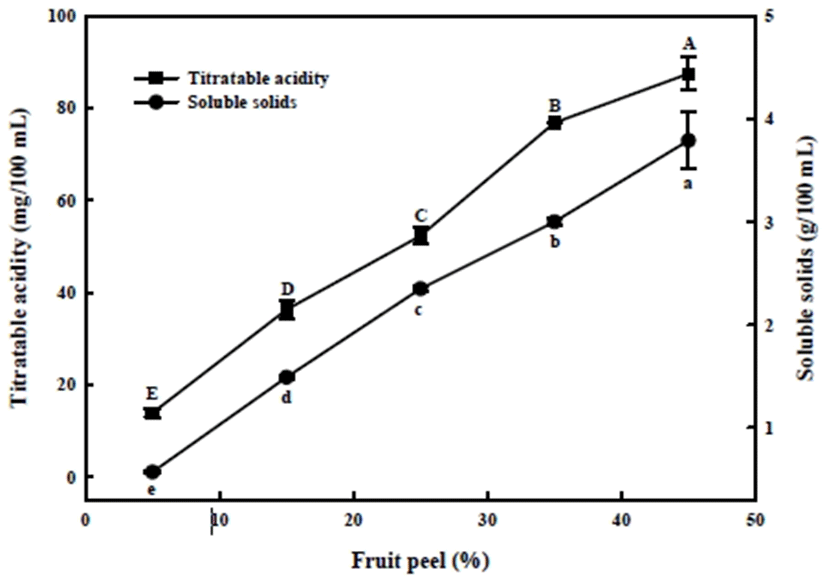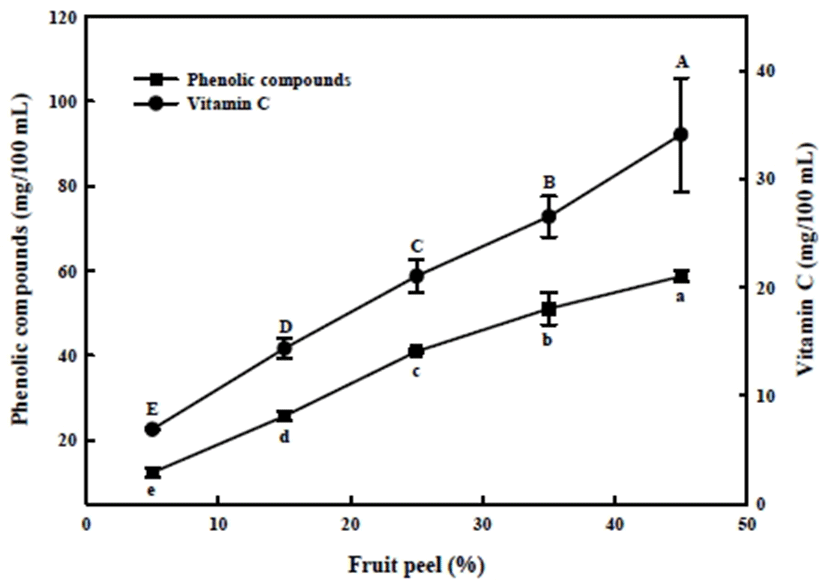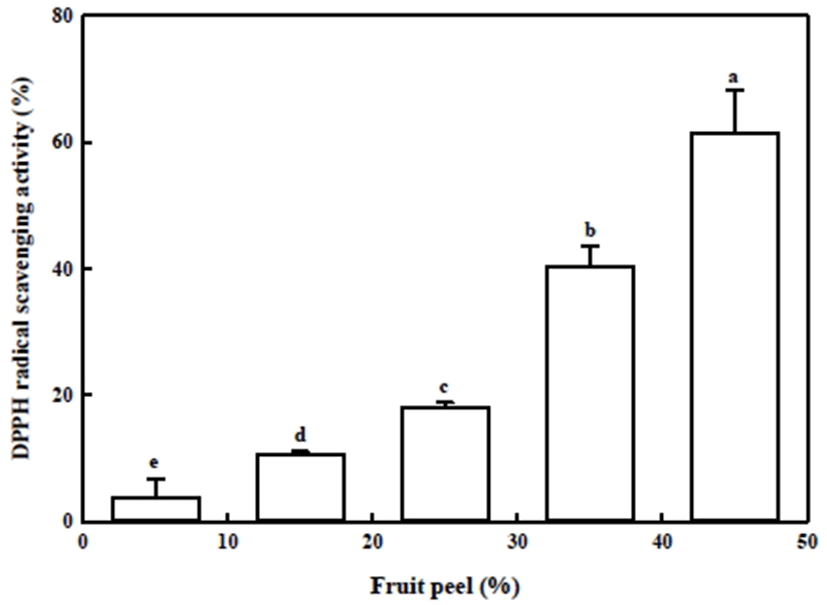서 론
유자나무(Citrus junos)는 동아시아 지역이 원산지와 주재배지이고, 귤속 식물 중 내한성과 내병성이 비교적 강한 상록관목이며, 그 열매는 과피가 두껍고 표면이 울퉁불퉁하며 종자가 많고 강한 산미와 고유한 향을 가져 직접 생식용보다는 당절임차 형태로 주로 소비되고 있다(1). 최근 들어 유자 과실의 면역력 증진 및 미백 효과(2,3), 과피의 항산화 효과(4), 종실의 항비만, 항산화 및 항암 효과(5-7), 정유의 항아토피 효과(8) 등의 건강 기능성이 알려지면서 유자의 고부가가치화와 가공제품의 다양화에 대한 관심이 증대되고 있다.
유자 과실의 가공에 관한 연구로서, 과즙 관련으로는 착즙방법별 과즙의 품질특성 조사(9,10), 과즙 식초(11)와 분말(12) 제조, 과즙을 첨가한 양파발효음료(13), 마요네즈(14), 된장(15), 소스(16), 과편(17), 아이스크림(18), 젤리(19) 등의 제조와 착즙박의 펙틴 추출(20)이 있다. 그리고 과피 관련으로는 과피 침출차(21) 제조와 과피 소량첨가 막걸리(22), 진양주(23), 쿠키(24), 소시지(25) 제조 및 과피로부터 올레오레진(26) 제조와 초임계 이산화탄소 이용 휘발성 정유(27) 추출 등이 있다. 또한 과실 첨가 동치미(28)와 초콜릿(29) 제조와 냉동과실을 이용한 잼(30) 제조, 당알코올류 첨가 유자차(31) 제조, 유자청 첨가 발아현미다식(32)과 설기떡(33) 제조 등이 보고된 바 있다. 이상과 같이 유자의 활용 관련 연구들이 다수 수행되어 유용한 결과를 얻은 바 있고, 제주산 감귤류 과피를 이용한 침출주(liqueur) 제조를 위한 연구 보고(34)와 이탈리아에서 레몬 과피를 원료로 한 침출주의 일종인 ‘Limoncello’가 생산되는 것을 볼 때(35) 유자 과피의 경우도 약효성분과 고유 향을 최대한 살릴 수 있는 지역 특산 침출주 제조가 가능할 것으로 생각된다.
침출주는 에탄올과 물을 이용하여 재료에 함유된 유효성분이 침출되게 하는 주류제조의 한 방법으로 만든 제품이며 다양한 원료의 침출주 제조 관련 연구가 수행되었으며, 침출조건에 따른 감귤류(34), 참다래(36), 매실(37), 더덕(38), 화류(39), 약초(40), 커피(41) 등의 품질특성 분석 결과들이 보고된바 있다. 그러나 유자 과실은 물론 과피를 활용한 침출주 제조에 관한 연구결과는 거의 찾아보기 힘든 실정이다.
따라서 본 연구에서는 유자 과실의 고부가가치화와 가공제품의 다양화의 일환일 수 있는 침출주 제조에 유용한 기본 정보를 얻고자, 유자 과피를 이용한 주정 침출주 제조와 그의 이화학적 품질특성에 침출조건인 에탄올 농도와 침출 용매 대비 유자 과피 담금 비율이 미치는 영향을 조사하였다.
재료 및 방법
실험용 유자과실은 2016년 11월 15일 경상남도 남해군에서 수확한 ‘남해재래’ 품종을 다음 날 배송 받아 크기와 표면색도가 균일한 과실만 선별, 수세하고 과피와 과육을 분리한 후 과피 만을 사용하였다. 이때 과실 한 개당 평균 무게는 162±17 g(n=50)이었고 이 중 과피가 차지하는 비율은 약 42±2%이었다.
유자 과피를 8등분하여 광구 유리병에 넣고 여기에 발효주정(Daehan Ethanol Co., Seoul, Korea)을 희석한 에탄올 농도 10%, 20%, 30%, 40%, 50%(v/v)의 침출용매를 용매 대비 시료 담금 비율이 25%(w/v)가 되게 넣은 조건과 에탄올 농도 30%(v/v)의 침출용매를 용매 대비 시료 담금 비율이 5%, 15%, 25%, 35%, 45%(w/v)가 되게 넣은 조건으로 구분하고 20℃에서 1개월 동안 침출실험을 실시한 후 침출주의 품질특성에 에탄올 농도가 미치는 영향과 용매 대비 시료 담금 비율이 미치는 영향을 각각 조사하였다. 이때 적용한 에탄올 농도 범위는 시중 유통 주류의 에탄올 농도를 바탕으로 설정하였고, 침출기간은 감귤류의 기존보고(34)를 참고하여 설정하였다.
가용성 고형분 함량은 침출주 시료액 5 mL를 칭량접시에 담아 건조기(VS-1202D3N, Vision Scientific Co., Ltd., Bucheon, Korea)로 105℃에서 항량 도달 때까지 건조시킨 후 잔류물의 무게를 측정하였다.
적정산도는 침출주 시료액을 일정비로 희석하고 그 액 20 mL 취해 0.1 N NaOH 용액으로 pH 8.0이 될 때까지 적정하여 소비된 mL수를 citric acid로 환산하여 나타내었다.
총 페놀 함량은 침출주 시료액을 취해 Folin-Ciocalteu법(42)으로 측정하였다. 즉, 침출주 시료액 2 mL를 취하여 Folin-Ciocalteu reagent 2 mL를 가하고 3분간 정치한 다음 10% Na2CO3 용액 2 mL를 가하였다. 이 혼합액을 1시간 동안 정치한 후 spectrophotometer(UV1800, Shimadzu, Kyoto, Japan)를 이용하여 760 nm에서 흡광도를 측정하였고, caffeic acid 표준품으로 검량선을 작성하여 정량하였다.
총 비타민 C 함량은 침출주 시료액을 취해 5% metaphosphoric acid로 희석한 후 2,4-initrophenylhydrazine 비색법(43)으로 측정하였다.
침출주 시료액의 1,1-diphenyl-2-picrylhydrazyl(DPPH) radical scavenging activity는 Blois법(44)으로 측정하였다. 즉, 시료액 2 mL에 에탄올에 용해한 0.2 mmol/L DPPH 용액 2 mL 가하고 10초간 강하게 진탕하고 30분간 정치한 후에 spectrophotometer(UV1800, Shimadzu)를 이용하여 517 nm에서 흡광도를 측정하였다. DPPH 유리기 소거능은 다음 식으로 계산하였다. DPPH 유리기 소거능(%)=[1-(시료액의 흡광도/DPPH 용액의 흡광도)×100].
색도는 분광측색계(CM-5, Konika Minolta Inc., Tokyo, Japan)를 사용하여 투과색의 CIE L*, a*, b*, h°, C* 값을 각각 측정하였다. L* 값은 lightness를, +a*와 -a*값은 redness와 greenness를, +b*와 -b* 값은 yellowness와 blueness를 각각 나타낸다. h° 값은 색상(red-purple: 0°, yellow: 90°, bluish-green: 180°, blue: 270°)을 나타내고, a>0, b>0 이면 h°=tan-1(b/a)로, a<0, b>0 이면 h°=180°+tan-1(b/a)으로 각각 계산된다.
결과 및 고찰
유자 과피의 담금 비율을 25%로 고정하고 침출용매의 에탄올 농도(10-50%)에 따른 침출주의 가용성 고형분 함량과 적정산도를 측정한 결과는 Table 1에 나타낸 바와 같다. 가용성 고형분 함량은 전반적으로 2.19-2.39 mg/100 mL 범위를 보였고 에탄올 농도 40% 이상에서 다소 낮은 수준이었다. 이는 침출용매의 에탄올 농도 증가에 따른 극성 감소에 기인된 결과로 여겨진다(34,45). 감귤류 과피 침출주의 경우에도 에탄올 농도 30%보다 60%에서 낮은 가용성 고형분 함량을 보였다고 알려져 있다(34). 유자 과피 침출주의 적정산도는 에탄올 농도별 유의적인 차이를 보이지 않고, 51.20-56.53 mg/100 mL 범위를 보였다. 반면에 감귤류 과피 침출주는 에탄올 농도가 30%에서 95%까지 증가할수록 pH가 높아지고 매실 침출주의 유기산 함량은 에탄올 30-60% 범위 내에서 고농도 일수록 높은 경향이었다는 보고도 있다(34,37).
침출용매의 에탄올 농도(10-50%)에 따른 유자 과피 침출주의 총 페놀 함량, 총 비타민 C 함량, DPPH 유리기 소거능 및 색도 값(L*, -a*, b*)를 조사한 결과는 Table 1에 나타내었다. 총 페놀 함량은 전반적으로 37.23-44.17 mg/100 mL 범위 내에서 에탄올 농도가 높을수록 높은 경향을 보였다. 이와 유사한 결과로서, 매실 침출주의 총 페놀 함량의 경우 침출용매의 에탄올 농도가 45%보다 60%에서 높았다는 보고(37)와 머루의 에탄올 추출에서 에탄올 농도 50%까지는 농도에 비례하여 총 페놀 함량이 높았다는 보고(46)가 있다. 비타민 C 함량은 에탄올 농도가 높아짐에 따라 낮아지는 경향을 보였다. 이는 앞서 언급한 가용성 고형분 함량에서와 마찬가지로 추출용매의 극성 변화에 따른 비타민 C의 용해도 감소에 기인된 결과로 생각된다(34,45). DPPH 유리기 소거능은 에탄올 농도별 다소 차이는 보였으나 에탄올 농도 증감에 따른 뚜렷한 변화 경향은 보이지 않고, 17.95-28.39% 범위를 보였다. 색도는 에탄올 농도에 대응하는 뚜렷한 경향성을 보이지 않고 L* 값 97.50-98.05, a* 값 -6.16--7.91, b* 값 21.57-26.13을 각각 나타내었다.
이러한 결과를 볼 때, 침출용매의 에탄올 농도가 침출주의 이화학적 특성에 미치는 영향이 크지 않지만, 에탄올 농도 10%에서 50%까지 증가함에 따라 유자 과피 침출주의 가용성 고형분과 비타민 C 함량은 약간 감소하고, 반면에 총페놀 함량은 약간 증가하는 것으로 나타나 상호 상쇄효과를 감안할 때 유자과피 침출주 제조에 적합한 에탄올 농도는 약 30% 정도인 것으로 판단된다.
에탄올 농도가 30%인 용매에 유자 과피의 담금 비율(5-45%)를 달리한 침출주의 적정산도와 가용성 고형분 함량을 측정한 결과는 Fig. 1에 나타내었다. 침출주의 적정산도와 가용성 고형분 함량은 과피 비율이 증가함에 따라 거의 선형적으로 증가함을 보였다. 이는 과피 비율이 보다 높은 침출구에서 과피로부터 유기산과 유리당 등의 가용성 물질의 용출량이 많아진 결과에 기인된 것으로 생각된다. 유자 과피에는 유기산으로 citric acid, malic acid, oxalic acid 등이, 유리당으로 fructose, glucose, sucrose 등이 함유되어 있는 것으로 알려져 있다(47,48). 더덕 침출주(38)의 경우도 더덕 담금 비율이 증가할수록 총당과 환원당 및 불휘발성 성분 함량이 높았고, 매실 침출주(37)도 매실 담금 비율이 증가할수록 유리당과 환원당 함량 및 적정산도가 높았다는 보고가 있다.

페놀성 물질과 비타민 C는 대표적인 항산화 물질로 알려져 있어 그 함량은 식품의 건강 기능성 평가에 주요 지표로 활용되고 있다. 유자 과피의 담금 비율에 따른 침출주의 총 페놀 함량과 총 비타민 C 함량을 측정한 결과는 Fig. 2에 나타내었다. 침출주의 총 페놀과 총 비타민 C 함량은 유자 과피의 담금 비율이 증가함에 따라 정비례하여 높아지는 패턴을 보였다. 이러한 결과는 유자 과피 첨가 비율이 높은 조건에서 페놀과 비타민 C의 침출 양이 많았기 때문인 것으로 생각된다. 한편 더덕과 매실 침출주의 경우도 각각의 담금 비율이 높을수록 총 페놀 함량이 높았다는 보고(37,38)가 있다.

항산화능 평가의 척도로 DPPH 유리기 소거능을 측정하였으며(41), 유자 과피의 담금 비율에 따른 그 결과는 Fig. 3과 같다. 침출주의 DPPH 유리기 소거능은 유자 과피 담금 비율의 증가와 더불어 선형적으로 증가함을 보였다. 이는 앞서 언급한 항산화능 원인 물질로 알려진 페놀성 물질과 비타민 C의 용출량 증가에 기인된 결과로 여겨진다(Fig. 2).

유자 과피의 담금 비율에 따른 침출주의 색도를 비교한 결과는 Table 2와 같다. 침출주의 명도를 의미하는 L* 값은 과피의 담금비가 낮을수록 높은 경향을 나타내었으나 큰 차이는 없었다. 녹색도를 의미하는 -a* 값은 과피의 담금비가 높을수록 선형적으로 증가하는 패턴을 보였다. 황색도를 의미하는 b* 값도 과피의 담금비에 정비례하여 증가하는 경향을 나타내었다. 이는 유자 과피에 함유된 녹색과 황색 색소성분의 침출정도 차이에 기인된 것이며, 침출주의 색도에 과피의 담금 비율이 크게 영향을 미치는 것을 뒷받침 한다. 한편, 더덕 침출주의 경우도 더덕 담금 비율에 비례하여 황색도가 증가하였으며 이로 인해 높은 관능적 기호도를 가진다고 하였다(38).
이상의 결과를 종합해 보면, 유자 과피 침출주 제조에 있어 용매 대비 과피 담금 비율은 침출주의 이화학적 품질특성에 큰 영향을 미치는 것으로 확인되었다. 유자 과피의 산도, 가용성 고형분, 총 페놀, 총 비타민 C 함량, 항산화능 및 색도가 선형적으로 높아지는 것으로 나타나 유자 과피를 담금 비율이 5%에서 45%까지 증가할수록 침출주의 적정이용한 침출주 제조에 적합한 과피의 담금 비율은 45% 이상인 것으로 판단된다. 이러한 결과는 향후 유자 과피를 활용한 고품질 침출주 제조 최적조건 확립에 기여할 것으로 보이고, 또한 상품화를 위해서는 소비자의 기호도를 고려한 감미료 첨가 효과와 법률적 문제 관련 추가 연구가 필요할 것으로 생각된다.
요 약
유자 과피를 이용한 침출주(liqueur) 제조에 필요한 기본정보를 얻기 위하여, 침출용매의 에탄올 농도와 과피의 담금 비율이 침출주의 이화학적 품질특성에 미치는 영향을 조사하였다. 유자 과실로부터 과피만을 분리, 세절하고 일정량(25% 담금 비율)을 10%, 20%, 30%, 40%, 50% 에탄올 농도의 침출용매와 혼합하거나 침출용매(30% 에탄올) 대비 5%, 15%, 25%, 35%, 45%의 담금 비율로 혼합하여 20℃에서 30일간 침출한 다음 각 침출액의 품질특성을 분석하였다. 침출용매의 에탄올 농도가 증가함에 따라 유자 과피 침출주의 가용성 고형분과 총 비타민 C 함량은 약간 감소하는 경향을, 총 페놀 함량은 약간 증가하는 경향을 각각 나타내었다. 유자 과피의 담금 비율이 증가함에 따라 침출주의 가용성 고형분 함량, 적정산도, 총 페놀 함량, 총 비타민 C 함량, 항산화능 및 색도(-a* 값, b* 값)가 선형적으로 증가함을 보였다. 이로써 유자 과피를 이용한 침출주 제조가 가능하였고 그의 이화학적 품질특성에 침출용매의 에탄올 농도와 과피의 담금 비율이 미치는 영향이 규명되었으며, 침출주 제조에 침출용매(30% 에탄올) 대비 과피 담금 비율이 45% 이상 조건이 적합한 것으로 확인되었다.
